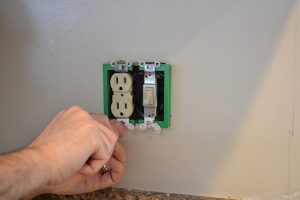Learn What the Kitchen Countertop Installer Neglected to Do When Installing a Kitchen Countertop Backsplash
By Mark J. Donovan
|
|
Question: Hi Mark, I recently had the backsplash completed in my kitchen and just found out that the electrical outlets were not properly secured. I attempted to plug an appliance into one of the electrical outlets and discovered that it was loose and went back into the wall. It turns out they all have the same problem. I can’t get an electrician to come in because they all tell me the job is too small. There are 5 sockets, and I want to secure them all and replace one of them with a GFCI switch. I am a female DIY willing to do it myself, but am fearful of being electrocuted because I’ve never done anything with electricity before.
I bought a 7 digital multimeter and longer screws. Can someone guide me through the testing of the electrical outlets after turning off the power (circuit breaker), aligning the outlets flush with the tile, and securing them so that they don’t move and the installation of the GFCI switch? |
I would really appreciate it, because my kitchen is currently non-functional until this electrical work is done. Thanks for any help you can provide. Delores
Answer: Delores, I am a little confused on your situation. Were the outlets securely mounted prior to the installation of the backsplash? I am assuming they were, otherwise the rough electrical would never have passed inspection and you would have experienced this problem long before. It’s also hard to understand how the electrical faceplates could have attached to the outlets themselves without the electrical outlets being extended outwards so that they were flush with the outer edge of the backsplash.
| Assuming the outlets were mounted properly, prior to the installation of the backsplash, I would suggest the following.
First turn off the circuit breaker that feeds power to the electrical outlets. To ensure the electrical outlets are powered off test them with your digital multimeter. Make sure the digital multimeter is set to 120VAC when making this test. Also insert the probes into the two vertical slits in the outlets, and not the roundish grounding hole. With the probes pushed into the vertical slits confirm you read a zero volt level on your multimeter. |
 |
You may also want to test an electrical outlet in another part of the home first, just to confirm the multimeter is working properly. On a powered outlet you should read around 110 to 120VAC. Since I’m assuming the electrical outlets are attached to the faceplate cover via the center screw you should be able to insert the test probes into the outlets.
If you can’t stick the two probes into the outlets because the outlets push back into the wall when you apply pressure on them, then to be extra safe turn off the main circuit breaker at the circuit panel. This will turn off power to your entire home. After turning off the main power you should be able to remove the faceplate covers and work with the electrical outlets safely.
| Now remove a faceplate cover from one of the outlets and observe if an electrical box extender was inserted to compensate for the extra depth caused by the installation of the backsplash. View my article on “How to Tile a Kitchen Backsplash” to see what an electrical box extender is.
I am assuming you won’t find one. If this is the case then simply pick up some electrical box extenders at your local hardware store and fasten them to the recessed electrical boxes. The extenders fasten to the top and bottom holes in the electrical boxes. You may need to use some longer screws to reach them due to the depth of the backsplash. Also you’ll have to thread the electrical outlets through the large openings in the extenders prior to attaching the extenders. |
 |
Once the electrical outlet extenders are on you can fasten the outlets to the extenders and then attach the faceplates. And that should do it. Turn the circuit breaker back on and you should be good to go.
GFCI Kitchen Outlets
In regards to the GFCI many times the GFCI is part of the circuit breaker. Thus you may not see a GFCI outlet in the kitchen. If you don’t see one in the kitchen, check the circuit breaker that powers the outlets and confirm if it is a GFCI type. If it is it will normally have a white button on it.
If you do have a GFCI outlet in the kitchen then you shouldn’t have to do anything to it other than maybe reset it by pushing the button on it. Simply install the outlet extender as described above.
For help on building a new custom home, see HomeAdditionPlus.com’s New Home Construction Bid Sheet. The New Home Construction Bid Sheet provides you with the knowledge on how to plan a custom home building project, and what to look for when hiring contractors for your new home construction. It also includes a detailed cost breakdown table and spreadsheet for estimating your own new home construction building costs.
Related Information
- Plastic versus Metal Electrical Boxes
- How to Install an Electrical Junction Box
- How to Tile a Kitchen Backsplash
Additional Electrical Wiring Resources from Amazon.com
 |
 |
Free Home Addition Price Quotes with No Obligation!
Fill out our 3-5 minute quick and easy form, and receive a free price quote on a house addition from one of our prescreened and licensed home addition contractors. This process is free and there is no obligation to continue once you receive your house addition price estimate.
